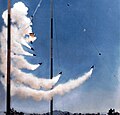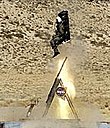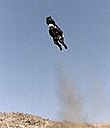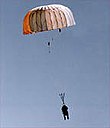Ejection seat
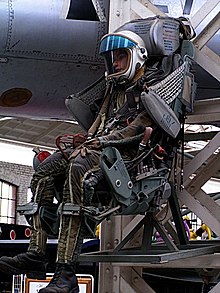
An ejection seat is a system used to rescue the crew of an airplane or helicopter in the event of an impending crash or an unavoidable collision. The ejection seat catapults itself together with the occupant out of the aircraft to a safe distance and possibly a safe height above the ground, automatically releases its parachute and then floats to the ground with the occupant. Ejection seats are mainly installed in military aircraft with a small crew (typically 1 to 2).
The crew members of propeller-powered aircraft were usually able to leave the aircraft and jump off on their own. The higher the airspeed, the more difficult it was. There was also the risk of being thrown against the aircraft, especially against the tail unit , by the airstream.
During the time of the Second World War, numerous types of aircraft were made faster by the installation of more powerful engines, and new, fast military aircraft , especially combat aircraft , were developed (→ History of Aviation ).
The main reason for the introduction of the ejector seat in the German air force towards the end of the Second World War was the acute shortage of experienced pilots , especially in night hunting . Crashed aircraft could be replaced, albeit with difficulty, but experienced fighter pilots could no longer be trained in sufficient numbers and used against the overpowering bomber pulks . The He 280 was the first aircraft in the world to have an ejection seat. On January 13, 1943, flight captain Helmut Schenk ignited the ejection seat of his He 280 during a test flight over the Müritz airfield ; this was the first emergency exit in aviation history . Schenk was unharmed; the He 280 crashed into a forest.
RA "Bob" Hoover was the first to use the ejection seat on a US aircraft, a Republic F-84 . His F-84 was out of control due to an engine failure and the pull on the trigger handle didn't work, so he opened the canopy, was sucked out and both legs broke at knee level. The ejection seat landed on the parachute; Hoover was found by a farmer hours after and survived.
Today's systems also work when the aircraft is still on the ground (so-called 0/0 seats; altitude = 0 / speed = 0; also written zero / zero) or rolls, but also at very high altitudes and at high flight speeds. An ejection seat consists of the seat, an explosive device, possibly a stabilization system, a round canopy parachute , an oxygen bottle for great heights and survival equipment consisting of a dinghy , radio , provisions, etc.
Most ejector seats catapult themselves up out of the plane; a few catapult themselves out, for example two of the six seats on the B-52 Stratofortress .
The phrase "sit in the ejector seat" is used to express metaphorically that someone holds a position that he can quickly lose again, e.g. B. has to perform a controversial task.
Procedure for an ejection seat exit
If the crew is in a life-threatening situation and the ejection seats are to be used to leave the aircraft, the following steps are carried out. The entire process from triggering the system to opening the parachute only takes 2-3 seconds:
- The pilot (here as an example) activates the mechanism by pulling one of the trigger handles (a handle is above the head and / or between or next to the legs) and thereby removes his hands from the control stick and / or the throttle. In the case of multi-seat aircraft, the reject is staggered with the rear seat from the back to the front. To avoid a collision in the air, one seat is catapulted to the left and the next to the right.
- In helicopters, an explosive charge separates the rotor blades from the shaft , which are thrown away by the centrifugal force and therefore no longer pose a threat to the crew.
- The roof or the window above the cockpit is removed. There are various methods of doing this, depending on the type of aircraft. For example, this can be done by detonating cords that are placed in a silicone sleeve and glued to the plastic glass of the cabin roof. Or the roof is thrown off using pneumatics. In some aircraft, scrap occurs through the closed roof, with the ejection seat breaking through the glass by means of a "thorn" attached to the top. With old types of aircraft, the cabin roof had to be thrown off manually beforehand. On some types of aircraft, the trigger handles on the head of the ejection seat were designed as a splinter protection hood. When triggered, the pilot pulled it over his face, which was only protected by the oxygen mask.
- The seat is often shot up from the aircraft by an "ejector seat cannon" (a telescopic tube with built-in pyrotechnic ammunition elements). During the upward movement of the seat, the legs attached to the seat with a rope and possibly also the arms of the pilot are pulled towards the seat via a deflection so that they are not injured.
- After the ejector seat cannon has extended to a precisely defined height, a rocket pack is detonated under the seat and catapults the pilot further upwards.
- Some ejection seats have a stabilization system that allows you to exit at minimum height or in an unfavorable aircraft position. This system brings the seat with control nozzles in a better position. In this way, a safe "exit" is guaranteed in every situation.
- With a small rocket (the Droguegun ) the auxiliary or control screen is shot out of the seat, which stabilizes the seat in the air.
- A barometric trigger regulates the further process: below a defined height (usually <5000 m) the seat is separated from the pilot and, depending on the model, falls either unbraked or fitted with a parachute to the ground. With the seat / man separation (different depending on the type) a larger auxiliary parachute or the main rescue parachute is pulled out of the seat pack first. This opens automatically and synchronously. An acceleration switch prevents the parachute from opening at speeds above 400 km / h, which is intended to prevent the parachute from tearing.
- At the same time as the ejection seat is triggered, the emergency oxygen supply on the seat is activated via the "PEC" and the connection and communication lines are disconnected from the aircraft.
- A fully automatic emergency radio transmitter on 243 MHz is also activated in order to enable targeted rescue operations even if the pilot is unconscious. The transmitter can also be used for two-way communication with the rescue team. The survival equipment and the dinghy are in an emergency equipment container; this is connected to the crew member via a packing envelope line.
- Landing of the pilot.
PEC (personal equipment connector)
With PEC a three-piece breakaway is called the pilot to the aircraft in case of an emergency exit on the hot seat for the rapid and simultaneous separation of all connections.
If, in an emergency, it is necessary for the pilot to get out of the ejector seat, the connections to the aircraft that are used to supply the pilot, such as the oxygen line, anti-g system, communication cables, etc., must be able to be disconnected quickly and without problems so that the pilot does not become disconnected strangled with the connecting cables during the exit phase, which took only 2-3 seconds.
The PEC consists of three parts, the aircraft part, the seat part and the pilot part. In the case of an ejection seat exit, this coupling first separates the aircraft-side feed of the supply lines from the seat and then also the connection on the pilot side.
Health damage
The rocket engines of the ejection seats are so powerful that serious spinal damage can result from scrap. The acceleration force ( g-force ) is 15 to 20 g for a fraction of a second, depending on the seat model. For comparison: the roller coaster limit and the start of a space shuttle are approx. 5 g, from approx. 6 g, unconsciousness occurs without special suits. Such enormous forces can only be endured due to the fact that the acceleration phase lasts very short.
A single exit using the ejector seat can therefore lead to the end of a pilot's career. Around 30% of jet pilots are no longer found fit to fly after an emergency exit. For the untrained, these exits can even be fatal.
The highest known survived speed of an ejection seat exit was Mach 2.6 at an altitude of 18,000 m. The Soviet test pilot Alexander Konovalov had to save himself over the Sormowo airfield in 1981 with a KM-1 from a MiG-25 Foxbat-B . He was wearing a pressure suit . Later, an accident with a then secret Lockheed SR-71 on January 25, 1966 over New Mexico became known, the test pilot William A. Weaver survived as one of the two crew members after he was at Mach 3.18 at an altitude of 22.9 km without an ejector seat, but parachuted out of the plane.
history
The first ejection seat was a German development from 1938. On January 13, 1943, the test pilot from Argus Motoren Gesellschaft , Dipl.-Ing. Rudolf Schenk, from the prototype V-1 of the He 280 equipped with Argus As 014 thrust tubes , which was towed by a Bf 110 . He had to get out because the tow rope on Schenk's plane did not come off the clutch due to icing. The world's second Ejection Seat Committee also took place in Germany. On July 15, 1943, flight captain Hans-Joachim Pancherz, had to test pilot at Junkers in Larz (Rechlin) from 290 Junkers Ju SB + QF, Wnr. 0156 after parts of the aircraft broke off while flying at the highest speed at the time. The first machine with a built-in ejection seat as standard was the Heinkel He 219 night fighter , which was developed in 1940 and from which 60 crew members were able to rescue themselves during the Second World War using an ejection seat.
The first ejection seats were powered by compressed air. Modern ejection seats are shot out of the aircraft by rockets. These can even be used on the ground (so-called zero-zero exit ) and from any flight position. The ejection seats from Martin-Baker , one of the leading manufacturers of these rescue systems, are said to have saved over 7,000 lives to date.
The ejection seat in the early models of the Starfighter was designed to shoot the pilot down from the cockpit. The Starfighter was a particularly fast aircraft; when catapulting out upwards, the pilot could have hit the rudder unit. Test pilot Iven C. Kincheloe therefore died in July 1958: he wanted to catapult himself out of his defective starfighter and could not because he was flying too low.
Since women also took part in combat missions from the 1990s, it became necessary to adapt the ejection seats to their average lower weight and size.
Milestones of the ejection seat
1st generation (1940-1965)
- 1941 Committee with compressed air catapult, manufacturer: Heinkel
- Mk.1 (manufacturer Martin Baker ) automatic reject, automatic opening of the control screen, manual separation from the seat and opening of the parachute by the pilot.
- Mk.2 first fully automatic ejection seat also near the ground.
- Mk.4 G-force -controlled blocking device in the release mechanism, which could release the parachute depending on the delay of the seat by the control screen.
- Mk.5 ...
- Mk.6 (around 1960) zero-zero performance, rejects at zero altitude and zero speed.
- April 1, 1961: first committee with a missile pack under the seat.
2nd generation (1965–1975)
- Mk.7 ...
- Mk.8 ...
- Mk.9 ...
- Mk.10 (A)
- Automatic, gas pressure operated body retrieval and holding system for the upper body for fixing rejects and forming a parallel reject and body axis. Arms and legs are pulled up to the upward moving ejection seat and held by arm and leg restraint straps.
- Emergency oxygen bottle on the seat. In the event of a committee at great heights or if the main oxygen supply fails during regular flight operations.
- Automatic control parachute and reserve system with independent seat-man separation. Can be activated manually in the event of failure (redundancy). Extremely stable reserve parachute with a maximum sink rate of 6.5 meters per second. The ejection seat is also "Zero-Zero" capable.
- The small and large control parachutes are primarily used to pull out the reserve parachute when separating the seat and the man below 5,000 meters, or to brake and stabilize the ejection seat that has been projected at great heights and has not yet been separated from the crew member. This should reach more life-friendly heights as quickly as possible before the separation takes place fully automatically at 5,000 meters. Separation of seat and man and opening of the reserve parachute are always a synchronous act in the rescue process.
- Emergency equipment container in the seat pan. The emergency equipment package and an inflatable boat that inflates automatically after contact with water are packed in a two-part packing case.
3rd generation (since 1975)

- S3S / S4S from Stencil works with its own speed and altitude measurement and is faster than the Mk.10. (After 1.8 seconds the pilot hangs on the parachute), a successful rescue is still possible even in inverted flight from 45 meters above the ground.
- Mk.11 ...
- Mk.12 mechanical mode selector selects three different types of rejects for altitudes below 2130 meters (7000 feet) depending on the flight altitude and speed
- Mode1 to Mode3.
- The control parachute is simply hung up, the time of parachute deployment is triggered by barostatic pressure and a mechanically controlled G-force limiter.
-
K-36 an ejection seat of the Soviet fighter aircraft. Two telescopic poles with a braking parachute are extended after the reject, stabilize the seat and pull it away from the pilot when the parachute opens. Scrap up to Mach 3 possible.
- The K-36RB ( version adapted for the Russian space shuttle Buran ) allows operational heights of up to 30,000 m and speeds of up to Mach 4.
- ACES II (Advanced Concept Ejection Seat) from McDonnell Douglas works with its own speed and height measurement (like the S4S) as a competitor to the Mk.12
- Boeing Military Airplane Company builds the CREST (Crew Escape Technologies) for altitudes up to 21,336 meters (70,000 feet) and 1300 km / h (700 knots)
- Mk.14 sensor system , electronic ( microprocessor- controlled) mode selector (coupled with the aircraft's data bus ), selects among five different types of rejects depending on the altitude and speed:
- "Mode 1" for speeds of up to 648 km / h and altitudes of up to 2438 meters
- "Mode 2" for speeds of 648 to 926 km / h and altitudes of up to 2438 meters
- "Mode 3" for speeds above 926 km / h up to an altitude of 2438 meters
- "Mode 4" for altitudes between 2438 and 5486 meters
- "Mode 5" for altitudes above 5486 meters
- Time of parachute deployment at the earliest after 0.35 seconds and below 650 km / h
- Mk.14 The weight of the seat is 90 kilograms
- Mk.14L The weight of the seat in the light version has been reduced by 30% to approx. 63 kilograms through the use of composite materials ( aluminum-lithium alloys ).
- Mk.15 was built into the Pilatus PC-7 .
3rd generation ejection seats are the Martin Baker Mk.14 , McDonnell Douglas ACES II and the Stencil S4S .
4th generation (since February 1992)
The fourth generation ejection seats include:
- Mk.16 high speed
- Mk.16A - EF Mk.16A - EF ...
- Mk.16 low-speed ...
- Mk.16E JSF (also US16E) was successfully tested in 2005
- Mk.F16F - Rafale ...
Further developments
- As an alternative to shooting out the pilot's seat, systems have also been developed in which the entire cockpit capsule (as an escape capsule ) is separated from the aircraft fuselage (e.g. on the F-111 ). There are no such rescue options for civil aircraft, in particular passenger aircraft.
- The American development of a rescue seat , which began after the Vietnam War , was also interesting . An ejection seat, which had a turbine driven drive according to the Committee, which in conjunction with a fold-out rotor for gyroplane was transformed. The range was specified with 100 km and 185 km / h top speed.
- The first helicopter to be equipped with an ejection seat is the Russian Kamow Ka-50 "Hokum" , which was developed in 1980 . Together with its further development, the Kamow Ka-52 Alligator , it is the only helicopter that has so far been equipped with an ejection seat. The rotor blades are automatically blown off when the ejector seat is activated.
photos
NASA test with a dummy in the ejection seat of a Northrop F / A-18 , shot down from a standing position.
Manufacturer
- Martin-Baker (Great Britain)
- NPP Zvezda (Russia)
- McDonnell Douglas (USA)
- Stencel (USA)
- Jianghan (China)
literature
- A. Geertz: Limits and special problems when using seated catapults , dissertation, TH Stuttgart, November 1944.
- S. Ruff, M. Ruck, G. Sedelmayr: Safety and Rescue in Aviation , Bernard & Graefe Verlag, Koblenz 1989, ISBN 3-7637-5293-5 .
- Heinz AF Schmidt: Lexikon der Luftfahrt , Motorbuch-Verlag, Berlin 1971, ISBN 3-87943-202-3 , pages 325, 326, (308, 309).
English literature:
- METEOR EJECT by Nick Carter, ISBN 1-873203-65-9 , published by Woodfield Publishing, 2001.
- MAN IN THE HOT SEAT , Doddy Hay, Pub. Collins, London 1969.
- PANIC TAKES TIME by TW Dumbo Willans Pub. Parrish, London 1956.
- EJECT, EJECT by Bryan Philpott, ISBN 0-7110-1804-9 , Published by Ian Allan.
- EJECT - The complete history of US aircraft escape systems by Jim Tuttle, Pub. Motorbooks, 2002, ISBN 0-7603-1185-4 .
- The Story of an Enterprise . Pub Martin Baker Aircraft Co Ltd 1955. This is a rare book which was given away by the company.
- Engineering for Life - The story of Martin Baker by John Jewell. Pub by Martin Baker Aircraft Co Ltd.
- United States Combat Aircrew Survival Equipment by Michael S Breuninger, pub. Schiffer Military History Books. Library of Congress No.93-90752.
- Bone Domes and Speed Jeans by Hans and Mike Halberstadt. Pub by Windrow and Green. ISBN 1-85915-081-0 .
- No Escape Zone by Nick Richardson. Pub Little, Brown and Co London 2000. ISBN 0-316-85314-3 .
- Jump For It , The story of the Caterpillar Club by Gerald Bowman. Pub by White Lion. ISBN 0-85617-739-3 .
- Wild Blue by David Fisher and William Garvey. Pub by Mainstream Publishing. ISBN 1-84018-403-5 .
- Sir James Martin , The authorized biography of the Martin Baker ejection seat pioneer. by Sarah Sharman. 1996, ISBN 1-85260-551-0 .
- Test Pilots by Wolfgang Späte. Pub by Independent Books. ISBN 1-872836-20-8 .
- JUMP FOR IT by Gerald Bowman (Stories of the Caterpillar Club). Great Pan Books pub 1957.
- BROKEN WINGS , POST WAR ROYAL AIR FORCE ACCIDENTS, by James J Halley MBE Pub. Air Britain Publications. ISBN 0-85130-290-4 .
- ML Aviation Ltd (A Secret World), by Graham Carter. Published by Keyham Books ISBN 0-9527715-6-X , 2006.
Web links
- (English)
- (English)
- (English)
- Video: Ejection Seat Committee during an air show
- Sukhoi K-36
- Aircrew equipment assemblies engl. PDF (MK.1-4; 8.14 MB)
- Welt online "Mk 16E" Explosive seating 2003 (accessed February 20, 2009)
- Escape Systems
swell
- ↑ History of and How Jet Engines Work (full documentary), youtube.com April 1, 2015 (Video 44:20) 6:00 pm - 7:50 pm, accessed September 9, 2015.
- ↑ Lexicon of Aviation, p. 326.
- ↑ a b Stefan Schmitt: So close to heaven. How modern ejection seats achieve technical masterpieces . In: time knowledge . No. 1 , December 10, 2008, p. 68–71 (“The moment the tube in the backrest and the one on the cockpit floor are separated, the thrust suddenly decreases. This was a problem for the engineers for a long time: if they used a propellant that was too weak, the pilot could not come safely If they were too strong, they risked spinal injuries. The problem became even more acute when the first women boarded fighter jets. After all, an ejection seat must be able to bring their on average delicate bodies to safety as unscathed as that of a much heavier one and clearly taller man. ").
- ↑ Aviation Week & Space Technology, August 8, 2005, pp. 60–62.
- ^ Aviation Lexicon, p. 326.
- ↑ Martin-Baker website.
- ↑ spiegel.de / one day: They called him the "beautiful death"
- ^ The History and Developments of Martin Baker America. (PDF; 54 kB) (No longer available online.) Martin-Baker Aircraft Company , July 4, 2012, p. 8 f , archived from the original on March 27, 2014 ; accessed on June 13, 2019 .
- ↑ “Generations 1–4” of ejection seats
- ↑ PM Peter Moosleitner Magazin 7/1979.
- ↑ PM Peter Moosleitner Magazin 11/1983.
- ↑ Mk.13 (does not exist!)
- ↑ Flug Revue No. 9 / September 1987.
- ↑ Flight International of March 29, 1996
- ^ Air Force Research Laboratory: Ejection Seat Capabilities to meet agile aircraft requirements. Retrieved August 2, 2013 .
- ↑ MK16 Highspeed ( Memento from March 15, 2011 in the Internet Archive ) YouTube video
- ↑ Lexicon of Aviation, p. 308 u. 309





